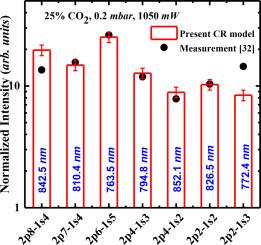当前位置:
X-MOL 学术
›
Spectrochim. Acta B. At. Spectrosc.
›
论文详情
Our official English website, www.x-mol.net, welcomes your
feedback! (Note: you will need to create a separate account there.)
Diagnostic of Ar-CO2 mixture plasma using a fine-structure resolved collisional radiative model
Spectrochimica Acta Part B: Atomic Spectroscopy ( IF 3.2 ) Pub Date : 2021-01-01 , DOI: 10.1016/j.sab.2020.106019 Neelam Shukla , Reetesh Kumar Gangwar , Rajesh Srivastava
Spectrochimica Acta Part B: Atomic Spectroscopy ( IF 3.2 ) Pub Date : 2021-01-01 , DOI: 10.1016/j.sab.2020.106019 Neelam Shukla , Reetesh Kumar Gangwar , Rajesh Srivastava

|
Abstract In the present work, we develop a collisional radiative (CR) model for the Ar-CO2 mixture plasma. The model is applied to the diagnostics of a recently reported low-pressure DC generated Ar-CO2 plasma of Rodriguez et al. [Phys. Plasmas 25, 053512 (2018)] utilizing their spectroscopic measurements who reported the plasma parameters at different concentrations of CO2 in Ar at various pressures and powers. Our CR model includes various population transfer mechanisms between the fine structure levels, viz., electron-impact excitation, radiative decay, and ionization, as well as their reverse processes, e.g., electron-impact de-excitation as well as two- and three-body recombination. The effects of radiation trapping and diffusion are also taken into account. The plasma parameters viz. electron density (ne) and electron temperature (Te) are obtained as a function of different pressures (0.2, 0.3, and 0.6 mbars) and discharge powers at 25 and 50% concentrations of CO2 in argon. These results are determined using measured intensities of seven intense emission lines out of 3p54p (2pi) → 3p54s (1si) fine-structure transitions. It is observed that both the electron density and electron temperature increase with the increase of CO2 concentration, which is in confirmation with experimental predictions. The populations obtained for 1si and 2pi levels from our CR model are also reported and compared respectively with the corresponding available values from the simple CR model and experiment of Rodriguez et al. [Phys. Plasmas 25, 053512 (2018)]. A significant difference in the populations is observed from the two models.
中文翻译:

使用精细结构分辨的碰撞辐射模型诊断 Ar-CO2 混合等离子体
摘要 在目前的工作中,我们开发了 Ar-CO2 混合等离子体的碰撞辐射 (CR) 模型。该模型应用于 Rodriguez 等人最近报道的低压直流产生的 Ar-CO2 等离子体的诊断。[物理。Plasmas 25, 053512 (2018)] 利用他们的光谱测量报告了在不同压力和功率下 Ar 中不同 CO2 浓度下的等离子体参数。我们的 CR 模型包括精细结构水平之间的各种种群转移机制,即电子撞击激发、辐射衰变和电离,以及它们的反向过程,例如电子撞击去激发以及二和三-身体重组。辐射捕获和扩散的影响也被考虑在内。等离子体参数即。获得电子密度 (ne) 和电子温度 (Te) 作为不同压力(0.2、0.3 和 0.6 毫巴)和在氩气中 CO2 浓度为 25% 和 50% 时的放电功率的函数。这些结果是使用 3p54p (2pi) → 3p54s (1si) 精细结构转变中的 7 条强发射线的测量强度确定的。观察到电子密度和电子温度都随着 CO2 浓度的增加而增加,这与实验预测一致。还报告了从我们的 CR 模型中获得的 1si 和 2pi 水平的种群,并分别与来自简单 CR 模型和 Rodriguez 等人的实验的相应可用值进行了比较。[物理。等离子 25, 053512 (2018)]。从两个模型中可以观察到种群的显着差异。
更新日期:2021-01-01
中文翻译:

使用精细结构分辨的碰撞辐射模型诊断 Ar-CO2 混合等离子体
摘要 在目前的工作中,我们开发了 Ar-CO2 混合等离子体的碰撞辐射 (CR) 模型。该模型应用于 Rodriguez 等人最近报道的低压直流产生的 Ar-CO2 等离子体的诊断。[物理。Plasmas 25, 053512 (2018)] 利用他们的光谱测量报告了在不同压力和功率下 Ar 中不同 CO2 浓度下的等离子体参数。我们的 CR 模型包括精细结构水平之间的各种种群转移机制,即电子撞击激发、辐射衰变和电离,以及它们的反向过程,例如电子撞击去激发以及二和三-身体重组。辐射捕获和扩散的影响也被考虑在内。等离子体参数即。获得电子密度 (ne) 和电子温度 (Te) 作为不同压力(0.2、0.3 和 0.6 毫巴)和在氩气中 CO2 浓度为 25% 和 50% 时的放电功率的函数。这些结果是使用 3p54p (2pi) → 3p54s (1si) 精细结构转变中的 7 条强发射线的测量强度确定的。观察到电子密度和电子温度都随着 CO2 浓度的增加而增加,这与实验预测一致。还报告了从我们的 CR 模型中获得的 1si 和 2pi 水平的种群,并分别与来自简单 CR 模型和 Rodriguez 等人的实验的相应可用值进行了比较。[物理。等离子 25, 053512 (2018)]。从两个模型中可以观察到种群的显着差异。











































 京公网安备 11010802027423号
京公网安备 11010802027423号